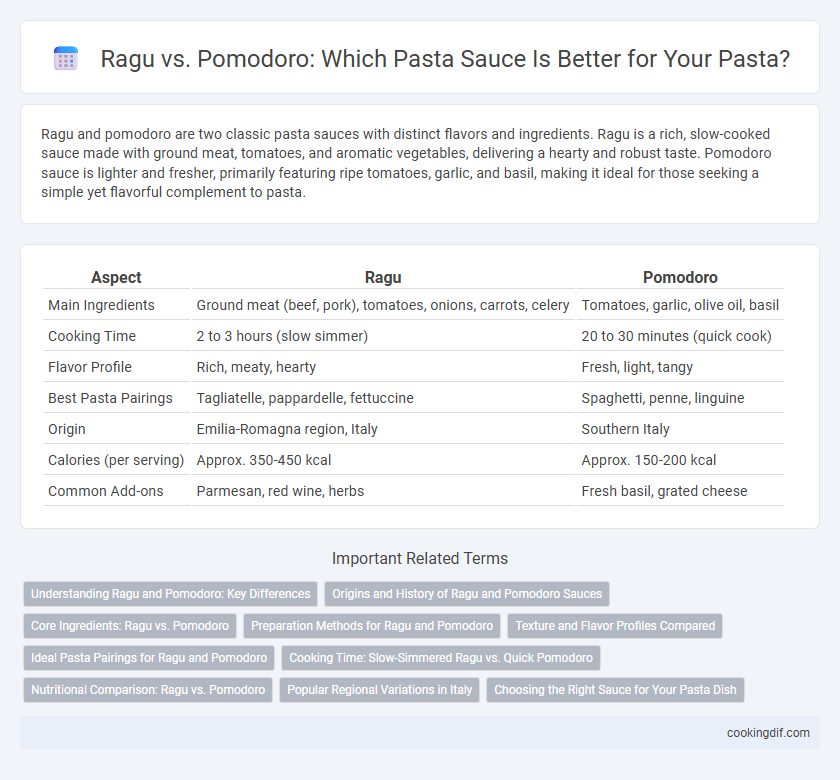Ragu and pomodoro are two classic pasta sauces with distinct flavors and ingredients. Ragu is a rich, slow-cooked sauce made with ground meat, tomatoes, and aromatic vegetables, delivering a hearty and robust taste. Pomodoro sauce is lighter and fresher, primarily featuring ripe tomatoes, garlic, and basil, making it ideal for those seeking a simple yet flavorful complement to pasta.
Table of Comparison
| Aspect | Ragu | Pomodoro |
|---|---|---|
| Main Ingredients | Ground meat (beef, pork), tomatoes, onions, carrots, celery | Tomatoes, garlic, olive oil, basil |
| Cooking Time | 2 to 3 hours (slow simmer) | 20 to 30 minutes (quick cook) |
| Flavor Profile | Rich, meaty, hearty | Fresh, light, tangy |
| Best Pasta Pairings | Tagliatelle, pappardelle, fettuccine | Spaghetti, penne, linguine |
| Origin | Emilia-Romagna region, Italy | Southern Italy |
| Calories (per serving) | Approx. 350-450 kcal | Approx. 150-200 kcal |
| Common Add-ons | Parmesan, red wine, herbs | Fresh basil, grated cheese |
Understanding Ragu and Pomodoro: Key Differences
Ragu is a slow-cooked meat-based sauce typically made with ground beef, pork, or veal combined with tomatoes, onions, and herbs, resulting in a rich, hearty flavor ideal for thick pastas like pappardelle. Pomodoro, originating from Naples, is a simple, fresh tomato sauce made with ripe tomatoes, garlic, olive oil, and basil, emphasizing bright, clean flavors that pair perfectly with long pasta strands such as spaghetti. Understanding these key differences helps in selecting the right sauce to complement pasta textures and desired meal richness.
Origins and History of Ragu and Pomodoro Sauces
Ragu originates from Northern Italy, particularly Bologna, and is traditionally a slow-cooked meat-based sauce combining ground beef, pork, and tomatoes, evolving from 18th-century culinary practices. Pomodoro sauce, rooted in Southern Italy, especially Naples, dates back to the late 18th century when tomatoes became widely incorporated into Italian cuisine, emphasizing fresh, simple tomato flavors. Both sauces reflect regional agricultural products and historical food preservation techniques, shaping their distinct textures and flavor profiles in Italian culinary history.
Core Ingredients: Ragu vs. Pomodoro
Ragu is a meat-based sauce featuring key ingredients such as ground beef or pork, tomatoes, onions, carrots, and celery, slowly simmered to develop a rich, hearty flavor. Pomodoro sauce centers on fresh, ripe tomatoes, garlic, olive oil, and basil, offering a light, vibrant taste that highlights the natural sweetness of the tomatoes. The distinct core ingredients define ragu's robust, savory depth compared to pomodoro's bright and fresh tomato essence.
Preparation Methods for Ragu and Pomodoro
Ragu requires slow simmering of ground meat, vegetables, and tomatoes over low heat to develop deep, rich flavors and a thick consistency. Pomodoro sauce involves quickly sauteing garlic and fresh tomatoes, creating a light and fresh sauce that preserves the natural acidity of the tomatoes. Ragu's longer cooking time transforms ingredients into a hearty, concentrated sauce, while Pomodoro's brief preparation ensures a bright and vibrant taste.
Texture and Flavor Profiles Compared
Ragu offers a rich, hearty texture with slow-cooked meat and vegetables creating a deep, savory flavor profile that clings well to pasta. Pomodoro features a lighter, smoother texture with fresh tomatoes and herbs delivering a bright, tangy taste that enhances the pasta's natural flavors. The contrasting textures and flavor intensities make ragu ideal for robust pasta types, while pomodoro suits delicate, thinner noodles.
Ideal Pasta Pairings for Ragu and Pomodoro
Ragu, a rich meat-based sauce often prepared with ground beef, pork, or veal, pairs ideally with hearty pasta shapes like pappardelle, rigatoni, or tagliatelle that can support its thick texture. Pomodoro sauce, a lighter tomato-based sauce made from fresh tomatoes, garlic, and basil, is best complemented by delicate pasta such as spaghetti, linguine, or penne, which allows the fresh flavors to shine through. Matching the sauce's consistency and intensity with the pasta shape enhances the overall taste and texture experience.
Cooking Time: Slow-Simmered Ragu vs. Quick Pomodoro
Ragu sauce requires slow simmering for several hours, allowing the meat to tenderize and flavors to deeply meld, creating a rich and hearty texture ideal for robust pasta dishes. In contrast, Pomodoro sauce is cooked quickly, typically within 20 to 30 minutes, preserving the freshness and bright acidity of ripe tomatoes for a light, vibrant complement to pasta. The extended cooking time of ragu enhances complexity and depth, while pomodoro delivers a straightforward, fresh tomato flavor.
Nutritional Comparison: Ragu vs. Pomodoro
Ragu sauce, typically made with ground meat, tomatoes, onions, and herbs, offers higher protein and fat content compared to pomodoro, which is primarily a tomato-based sauce with garlic and basil, resulting in lower calories and fat. Pomodoro sauce provides more vitamin C and antioxidants due to its fresh tomato emphasis and minimal cooking time. Choosing between ragu and pomodoro depends on desired nutritional goals, whether seeking more protein and richness or a lighter, antioxidant-rich option.
Popular Regional Variations in Italy
Ragu and Pomodoro represent two iconic Italian pasta sauces distinguished by regional preferences and ingredients. Ragu, especially Ragu alla Bolognese from Emilia-Romagna, features slow-cooked minced meat, tomatoes, and aromatic vegetables, providing a rich, hearty flavor ideal for tagliatelle or lasagna. Pomodoro, prevalent in Southern Italy and notably in Naples, emphasizes fresh tomatoes, garlic, basil, and olive oil, creating a lighter, vibrant sauce perfect for spaghetti or penne.
Choosing the Right Sauce for Your Pasta Dish
Ragu, a rich meat-based sauce simmered with tomatoes and aromatic herbs, provides a hearty and robust flavor ideal for thicker pasta shapes like pappardelle or rigatoni. Pomodoro sauce, made with fresh tomatoes, garlic, basil, and olive oil, offers a lighter, fresher taste that complements delicate pasta such as spaghetti or linguine. Selecting the right sauce depends on pasta texture and the desired balance between intense richness and vibrant freshness.
ragu vs pomodoro for pasta sauces Infographic

 cookingdif.com
cookingdif.com